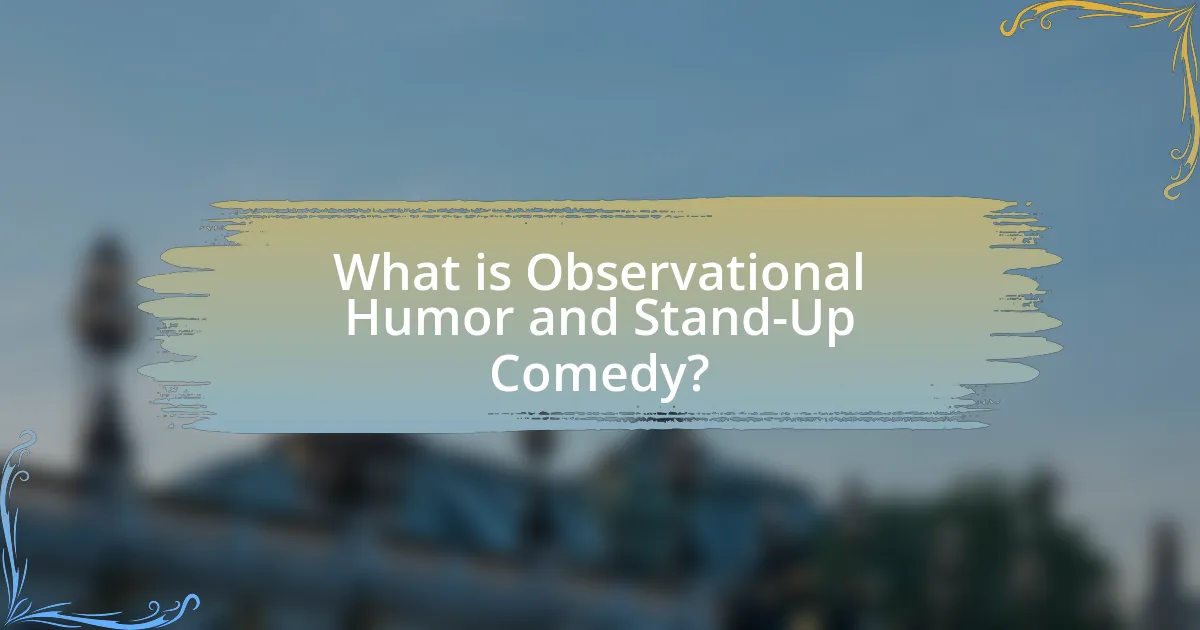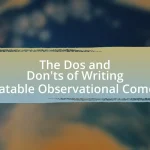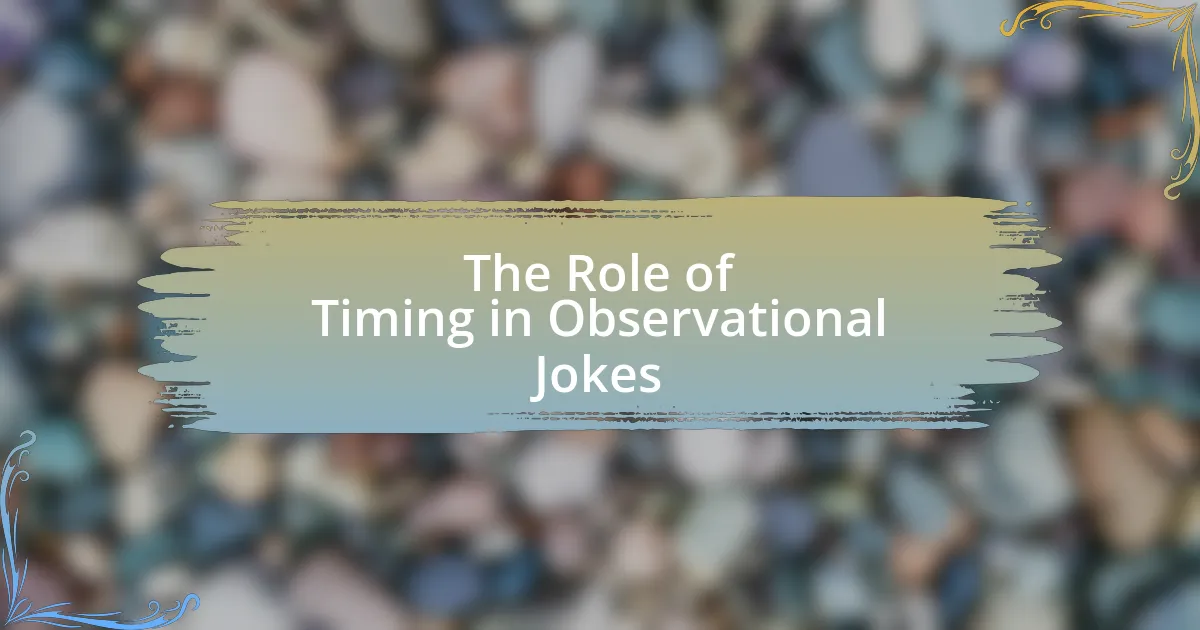Observational humor is a comedic style that emphasizes everyday life experiences and relatable situations, while stand-up comedy is a performance art where comedians deliver jokes and anecdotes to an audience. The article explores the differences between these two forms of comedy, highlighting their unique characteristics, historical origins, and audience expectations. It discusses how comedians utilize observational humor within their stand-up routines, the techniques employed, and the challenges they face. Additionally, the article examines the benefits of mastering these comedic styles and offers practical tips for improving skills in observational humor and stand-up comedy.

What is Observational Humor and Stand-Up Comedy?
Observational humor is a comedic style that focuses on everyday life experiences and relatable situations, often highlighting the absurdities of mundane activities. Stand-up comedy, on the other hand, is a performance art where a comedian delivers a series of jokes, stories, and anecdotes directly to an audience, typically in a solo format. Both forms rely on the comedian’s ability to connect with the audience through shared experiences, but observational humor specifically emphasizes the nuances of daily life, while stand-up comedy encompasses a broader range of comedic techniques and topics.
How do Observational Humor and Stand-Up Comedy differ in style?
Observational humor and stand-up comedy differ primarily in their focus and delivery style. Observational humor centers on everyday experiences and relatable situations, often highlighting the absurdities of daily life, while stand-up comedy encompasses a broader range of topics, including personal anecdotes, social commentary, and various comedic styles.
For instance, comedians like Jerry Seinfeld exemplify observational humor by drawing humor from mundane experiences, such as waiting in line or the quirks of social interactions. In contrast, stand-up comedians like Chris Rock may employ a mix of storytelling, satire, and political commentary, showcasing a more diverse range of comedic techniques. This distinction in focus and delivery style is crucial in understanding the unique characteristics of each form of comedy.
What are the key characteristics of Observational Humor?
Observational humor is characterized by its focus on everyday experiences and relatable situations. This type of humor often highlights the absurdities and quirks of daily life, making it accessible to a wide audience. Comedians who employ observational humor typically use keen observations and personal anecdotes to draw laughter from common scenarios, such as family dynamics, social interactions, and mundane activities. The effectiveness of observational humor lies in its ability to resonate with the audience’s own experiences, creating a shared understanding that enhances the comedic impact.
What defines Stand-Up Comedy as a performance art?
Stand-Up Comedy is defined as a performance art by its reliance on a solo performer delivering a structured narrative or series of jokes to an audience, often incorporating personal anecdotes and observational humor. This art form emphasizes the connection between the comedian and the audience, where timing, delivery, and audience interaction play crucial roles in eliciting laughter. The performance aspect is highlighted by the comedian’s ability to engage with the audience in real-time, adapting their material based on audience reactions, which distinguishes it from other forms of comedy. Historical evidence shows that stand-up comedy has evolved from vaudeville and has been a significant part of entertainment since the early 20th century, with notable figures like Lenny Bruce and Richard Pryor shaping its modern form.
What are the historical origins of Observational Humor and Stand-Up Comedy?
Observational humor and stand-up comedy originated in the late 19th and early 20th centuries, evolving from vaudeville and music hall performances. Vaudeville acts featured comedians who would share humorous anecdotes about everyday life, laying the groundwork for observational humor. Stand-up comedy emerged as a distinct form in the 1950s, with comedians like Mort Sahl and Lenny Bruce focusing on social commentary and personal experiences, which further popularized observational humor. The rise of television in the 1960s and 1970s, with shows like “The Ed Sullivan Show,” helped to mainstream stand-up comedy, allowing comedians to reach wider audiences and solidify the genre’s place in entertainment history.
How did Observational Humor evolve over time?
Observational humor evolved significantly from its early roots in the comedic styles of the 19th century to its contemporary form, characterized by a focus on everyday life and relatable experiences. Initially, comedians like Mark Twain and vaudeville performers used observational elements, but it was not until the 1970s and 1980s, with figures like George Carlin and Jerry Seinfeld, that observational humor became a dominant style in stand-up comedy. This shift was marked by a more structured approach to comedy, where comedians dissected mundane aspects of life, making them humorous through keen observation and relatable storytelling. The rise of television and comedy specials further popularized this style, allowing comedians to reach wider audiences and solidify observational humor as a staple in the comedic landscape.
What is the history of Stand-Up Comedy as a genre?
Stand-up comedy originated in the late 19th century, evolving from vaudeville and music hall performances where entertainers would engage directly with audiences. The genre gained prominence in the United States during the 1950s and 1960s, with comedians like Lenny Bruce and Mort Sahl pushing boundaries and addressing social issues. By the 1970s, stand-up became a staple of American entertainment, with the rise of comedy clubs and televised specials, exemplified by shows like “The Tonight Show” featuring comedians such as George Carlin and Richard Pryor. The 1980s and 1990s saw further diversification, with the emergence of alternative comedy and the influence of cable television, leading to a broader acceptance and popularity of stand-up as a distinct genre.
What are the audience expectations for Observational Humor and Stand-Up Comedy?
Audience expectations for observational humor and stand-up comedy primarily revolve around relatability and authenticity. Observational humor is expected to highlight everyday experiences and mundane situations in a way that resonates with the audience’s own lives, often leading to shared laughter over common frustrations or joys. In contrast, stand-up comedy generally anticipates a broader range of topics, including personal anecdotes, social commentary, and sometimes controversial material, delivered with a unique comedic style.
Research indicates that audiences favor comedians who can connect with them through shared experiences, as seen in a study published in the Journal of Humor Research, which found that relatability significantly enhances audience engagement and enjoyment. Thus, both forms of comedy rely on the comedian’s ability to understand and reflect the audience’s perspectives, but they do so through different thematic lenses and delivery styles.
How does audience engagement differ between the two styles?
Audience engagement differs significantly between observational humor and stand-up comedy. Observational humor often relies on relatable, everyday experiences, fostering a sense of connection and shared understanding among the audience, which can lead to a more intimate and interactive atmosphere. In contrast, stand-up comedy typically features a more structured performance with punchlines and setups that may not directly engage the audience in a conversational manner, resulting in a more passive reception. Research indicates that audiences respond more positively to observational humor due to its familiarity, as shown in studies where participants rated relatable jokes higher in enjoyment compared to traditional stand-up routines.
What reactions do Observational Humor and Stand-Up Comedy typically elicit?
Observational humor and stand-up comedy typically elicit laughter and amusement from audiences. Observational humor often resonates with listeners by highlighting relatable everyday experiences, prompting recognition and chuckles. Stand-up comedy, on the other hand, can evoke a broader range of reactions, including laughter, surprise, and sometimes discomfort, as it often tackles more controversial or personal topics. Research indicates that humor activates the brain’s reward system, reinforcing the positive emotional responses associated with both forms of comedy.
How do comedians utilize Observational Humor and Stand-Up Comedy in their routines?
Comedians utilize observational humor by drawing on everyday experiences and relatable situations, which they then incorporate into their stand-up routines to connect with audiences. This form of humor relies on keen observations of social norms, behaviors, and quirks, allowing comedians to highlight the absurdities of daily life. For example, Jerry Seinfeld is known for his observational style, often discussing mundane topics like waiting in line or the intricacies of relationships, making them humorous through relatable anecdotes. Stand-up comedy serves as the platform where these observations are delivered, allowing comedians to engage with the audience through timing, delivery, and personal storytelling, which enhances the comedic effect. The effectiveness of this approach is supported by research indicating that humor based on shared experiences fosters a sense of community and understanding among audience members, making the performance more impactful.
What techniques are commonly used in Observational Humor?
Observational humor commonly employs techniques such as exaggeration, relatable anecdotes, and irony. Exaggeration amplifies everyday situations to highlight their absurdity, making them more humorous. Relatable anecdotes draw on shared experiences, allowing audiences to connect with the humor on a personal level. Irony contrasts expectations with reality, creating a comedic twist that resonates with listeners. These techniques are effective because they tap into universal human experiences, making the humor accessible and engaging for a wide audience.
How do comedians craft relatable observations in their material?
Comedians craft relatable observations in their material by drawing from shared experiences and common societal norms. They often observe everyday situations, emotions, and interactions that resonate with a wide audience, allowing listeners to see themselves in the humor. For instance, comedians like Jerry Seinfeld focus on mundane aspects of life, such as waiting in line or dealing with technology, which are universally understood. This technique is effective because it taps into collective experiences, making the humor accessible and engaging. Research indicates that humor is more impactful when it reflects familiar scenarios, as it fosters a connection between the comedian and the audience, enhancing relatability and laughter.
What role does timing play in delivering Observational Humor?
Timing is crucial in delivering observational humor as it enhances the punchline’s impact and audience engagement. Effective timing allows comedians to build anticipation, creating a rhythm that maximizes the humor derived from relatable observations. Research indicates that well-timed pauses can increase laughter by allowing the audience to process the joke before reacting, thus reinforcing the comedic effect. For instance, a study published in the journal “Cognitive Science” by researchers at the University of California found that timing significantly influences the perception of humor, demonstrating that precise delivery can elevate the effectiveness of observational humor.
What are the challenges faced by comedians in Observational Humor and Stand-Up Comedy?
Comedians in observational humor and stand-up comedy face several challenges, including audience relatability, timing, and originality. Audience relatability is crucial, as comedians must connect their material to the experiences of their listeners; failure to do so can result in disengagement. Timing is essential in delivering punchlines effectively, as poor timing can diminish the impact of a joke. Originality poses a significant challenge, as comedians must create fresh content in a saturated market where many themes have been explored. These challenges require comedians to continuously refine their craft and adapt to changing audience preferences.
How do comedians handle audience reactions in Stand-Up Comedy?
Comedians handle audience reactions in stand-up comedy by adapting their performance in real-time to engage with the crowd’s responses. This adaptability allows comedians to incorporate spontaneous interactions, adjust their timing, and modify their material based on audience feedback, which can enhance the overall experience. For instance, a comedian may pause for laughter, respond to hecklers with quick wit, or shift topics if the audience shows disinterest. Research indicates that successful comedians often rely on audience engagement techniques, such as improvisation and observational humor, to create a dynamic atmosphere that resonates with the crowd.
What pitfalls should comedians avoid when using Observational Humor?
Comedians should avoid relying on clichés and stereotypes when using observational humor. Such reliance can lead to unoriginal material that fails to resonate with audiences, as it lacks freshness and authenticity. For instance, studies show that audiences prefer unique perspectives over recycled jokes, which can diminish a comedian’s credibility and connection with the audience. Additionally, comedians must be cautious about crossing the line into offensive territory; humor that targets specific groups can alienate audience members and provoke backlash. Research indicates that humor perceived as mean-spirited can negatively impact a comedian’s reputation and career longevity. Therefore, maintaining originality and sensitivity is crucial for effective observational humor.
What are the benefits of mastering Observational Humor and Stand-Up Comedy?
Mastering observational humor and stand-up comedy enhances communication skills and boosts confidence. These forms of comedy require keen observation of everyday life, allowing individuals to connect with audiences through relatable content. Research indicates that effective humor can improve social interactions and reduce anxiety, as laughter fosters a sense of belonging and eases tension. Additionally, comedians often develop strong storytelling abilities, which can be beneficial in various professional and personal contexts.
How can Observational Humor enhance a comedian’s performance?
Observational humor enhances a comedian’s performance by allowing them to connect with the audience through relatable experiences and everyday situations. This type of humor draws on common human behaviors and societal norms, making it easier for the audience to identify with the material. For instance, comedians like Jerry Seinfeld have successfully utilized observational humor to highlight mundane aspects of life, which resonates with a wide audience, leading to increased laughter and engagement. Research indicates that humor based on shared experiences can foster a sense of community among audience members, enhancing their overall enjoyment of the performance.
What skills can be developed through Stand-Up Comedy practice?
Stand-Up Comedy practice develops several key skills, including public speaking, timing, audience engagement, and creativity. Public speaking skills are honed as comedians perform in front of live audiences, learning to project their voice and convey their message effectively. Timing is crucial in comedy; comedians must master the rhythm of delivery to maximize the impact of their punchlines. Audience engagement skills are developed through the need to read the room and adapt material based on audience reactions. Creativity is fostered as comedians craft original jokes and narratives, often drawing from personal experiences or observations. These skills are essential not only in comedy but also in various professional and social contexts.
What practical tips can improve your Observational Humor and Stand-Up Comedy skills?
To improve your observational humor and stand-up comedy skills, practice regularly by writing and performing new material. Regular practice helps refine timing, delivery, and audience engagement, which are crucial for effective humor. Additionally, observe everyday situations and note relatable experiences, as these can serve as the foundation for observational humor. Research indicates that comedians who draw from personal experiences often connect better with audiences, enhancing relatability and laughter. Furthermore, recording performances and reviewing them can provide insights into what works and what doesn’t, allowing for continuous improvement.




